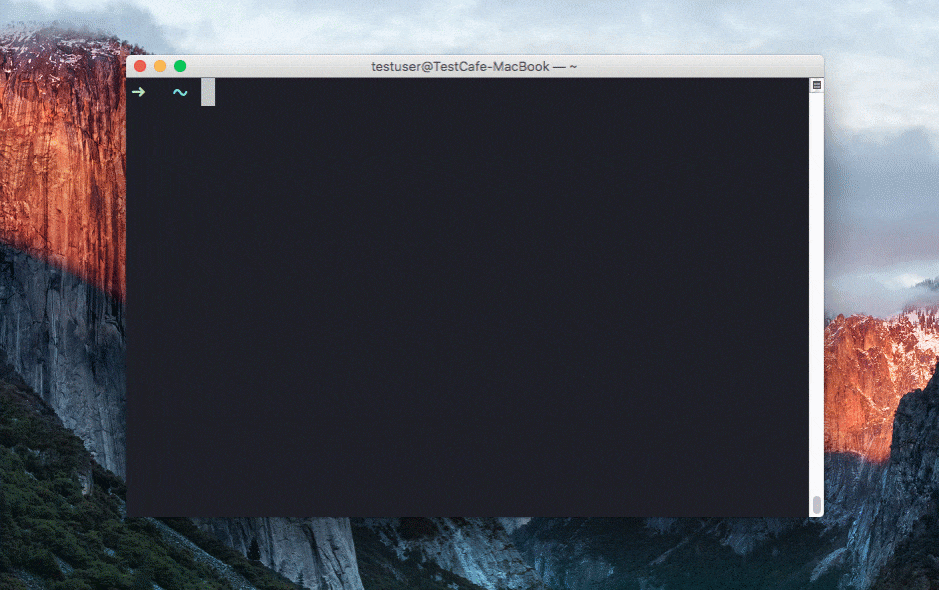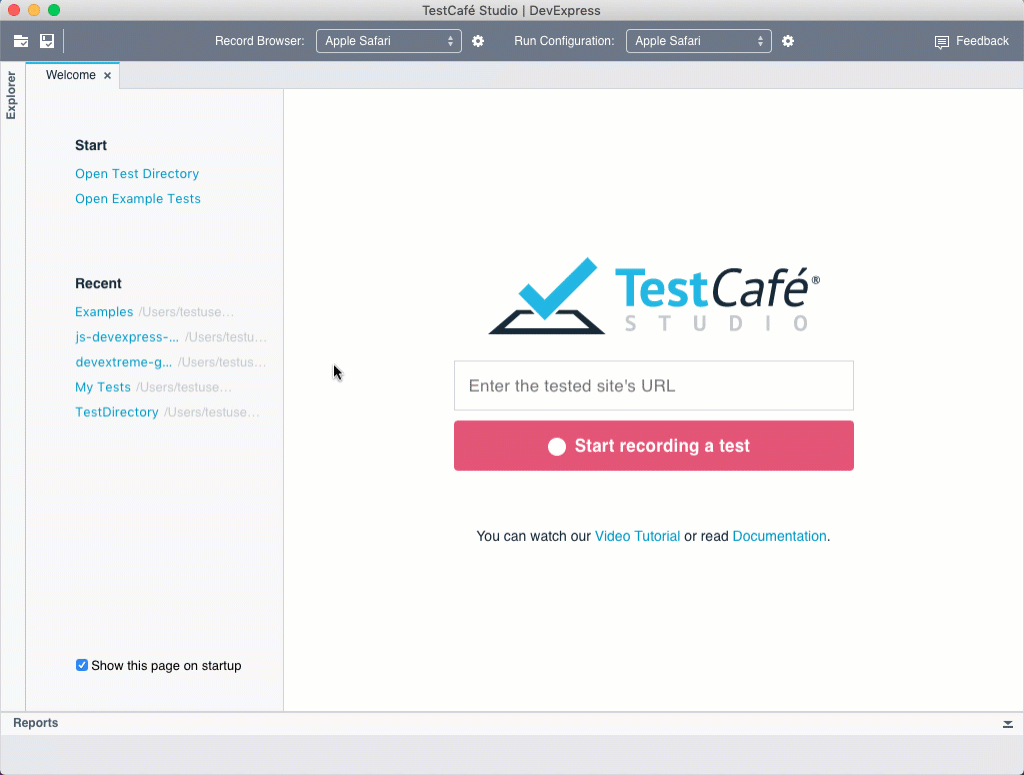What is testcafe?
TestCafe is an end-to-end testing framework for web applications. It allows you to write tests in JavaScript or TypeScript, run them across multiple browsers, and provides a rich set of features for automating user interactions and verifying application behavior.
What are testcafe's main functionalities?
Cross-browser Testing
TestCafe allows you to run tests across multiple browsers simultaneously. This code sample demonstrates how to set up TestCafe to run tests in both Chrome and Firefox.
const createTestCafe = require('testcafe');
let testcafe = null;
createTestCafe('localhost', 1337, 1338)
.then(tc => {
testcafe = tc;
const runner = testcafe.createRunner();
return runner
.src('tests/test.js')
.browsers(['chrome', 'firefox'])
.run();
})
.then(failedCount => {
console.log('Tests failed: ' + failedCount);
testcafe.close();
});
Assertions
TestCafe provides a rich set of assertions to verify the state of your application. This code sample demonstrates how to use assertions to check that the text of an element matches the expected value.
import { Selector } from 'testcafe';
fixture `Getting Started`
.page `http://devexpress.github.io/testcafe/example`;
const developerNameInput = Selector('#developer-name');
const submitButton = Selector('#submit-button');
const articleHeader = Selector('#article-header');
test('My first test', async t => {
await t
.typeText(developerNameInput, 'John Smith')
.click(submitButton)
.expect(articleHeader.innerText).eql('Thank you, John Smith!');
});
Screenshots and Video Recording
TestCafe allows you to take screenshots and record videos of your tests. This code sample demonstrates how to take a screenshot after performing some actions.
import { Selector } from 'testcafe';
fixture `Screenshot and Video`
.page `http://devexpress.github.io/testcafe/example`;
const developerNameInput = Selector('#developer-name');
const submitButton = Selector('#submit-button');
test('Take a screenshot', async t => {
await t
.typeText(developerNameInput, 'John Smith')
.click(submitButton)
.takeScreenshot();
});
Parallel Test Execution
TestCafe supports parallel test execution to speed up the testing process. This code sample demonstrates how to run tests in parallel with a concurrency factor of 3.
const createTestCafe = require('testcafe');
let testcafe = null;
createTestCafe('localhost', 1337, 1338)
.then(tc => {
testcafe = tc;
const runner = testcafe.createRunner();
return runner
.src('tests/test.js')
.browsers(['chrome', 'firefox'])
.concurrency(3)
.run();
})
.then(failedCount => {
console.log('Tests failed: ' + failedCount);
testcafe.close();
});
Other packages similar to testcafe
cypress
Cypress is a front-end testing tool built for the modern web. It offers a rich, interactive UI and a powerful API for writing tests. Compared to TestCafe, Cypress provides a more interactive debugging experience but is limited to running tests in Chrome and Electron.
selenium-webdriver
Selenium WebDriver is a widely-used tool for automating web browsers. It supports multiple programming languages and browsers. Compared to TestCafe, Selenium WebDriver offers more flexibility and control but requires more setup and configuration.
puppeteer
Puppeteer is a Node library that provides a high-level API to control Chrome or Chromium over the DevTools Protocol. It is great for automating browser tasks and scraping. Compared to TestCafe, Puppeteer is more low-level and requires more boilerplate code for writing tests.





A Node.js tool to automate end-to-end web testing.
Write tests in JS or TypeScript, run them and view results.
Homepage •
Documentation •
FAQ •
Support
- Works on all popular environments: TestCafe runs on Windows, MacOS, and Linux. It supports desktop, mobile, remote and cloud browsers (UI or headless).
- 1 minute to set up: You do not need WebDriver or any other testing software. Install TestCafe with one command, and you are ready to test:
npm install -g testcafe - Free and open source: TestCafe is free to use under the MIT license. Plugins provide custom reports, integration with other tools, launching tests from IDE, etc. You can use the plugins made by the GitHub community or make your own.

Running a sample test in Safari
Table of contents
Features
Stable tests and no manual timeouts
TestCafe automatically waits for page loads and XHRs before the test starts and after each action.
It also features smart test actions and assertions that wait for page elements to appear.
You can change the maximum wait time.
If elements load faster, tests skip the timeout and continue.
Rapid test development tool
Changes in test code immediately restart the test, and you see the results instantly.
See how it works in the TestCafe Live repository.
Latest JS and TypeScript support
TestCafe supports the latest JavaScript features, including ES2017 (for example, async/await).
You can also use TypeScript
if you prefer a strongly typed language.
Detects JS errors in your code
TestCafe reports JS errors that it finds on the webpage.
Tests automatically fail because of that.
However, you can disable this.
Concurrent test launch
TestCafe can open multiple instances of the same browser to run parallel
tests which decreases test execution time.
PageObject pattern support
The TestCafe's Test API
includes a high-level selector library, assertions, etc.
You can combine them to implement readable tests with the PageObject pattern.
const macOSInput = Selector('.column').find('label').withText('MacOS').child('input');
Easy to include in a continuous integration system
You can run TestCafe from a console, and its reports can be viewed in a CI system's interface
(TeamCity, Jenkins, Travis & etc.)
TestCafe Studio: IDE for End-to-End Web Testing
TestCafe works great for JavaScript developers, but at some point you will need to delegate testing tasks to your Q&A department. If that's the case and you are looking for a codeless way to record and maintain tests compatible with your existing infrastructure, check out TestCafe Studio - a testing IDE built on top of the open-source TestCafe.
Read the following article to learn how TestCafe Studio could fit into your workflow: What's Better than TestCafe? TestCafe Studio.

Record and Run a Test in TestCafe Studio
Getting Started
Installation
Ensure that Node.js (Current or Active LTS is recommended, version 12 at minimum) and npm are installed on your computer before running it:
npm install -g testcafe
Creating the Test
As an example, we are going to test the https://devexpress.github.io/testcafe/example page.
Create a .js or .ts file on your computer.
Note that it needs to have a specific structure: tests must be organized into fixtures.
You can paste the following code to see the test in action:
import { Selector } from 'testcafe';
fixture `Getting Started`
.page `https://devexpress.github.io/testcafe/example`;
test('My first test', async t => {
await t
.typeText('#developer-name', 'John Smith')
.click('#submit-button')
.expect(Selector('#article-header').innerText).eql('Thank you, John Smith!');
});
Running the Test
Call the following command in a command shell.
Specify the target browser
and file path.
testcafe chrome test1.js
TestCafe opens the browser and starts executing the test.
Important! Make sure the browser tab that runs tests stays active.
Do not minimize the browser window. Inactive tabs and minimized browser windows switch
to a lower resource consumption mode where tests are not guaranteed to execute correctly.
Viewing the Results
TestCafe outputs the results into a command shell by default. See Reporters
for more information. You can also use plugins to customize the reports.

Read the Getting Started page for a more detailed guide.
Documentation
Go to our website for full documentation on TestCafe.
Get Help
Join the TestCafe community on Stack Overflow to get help. Ask and answer questions with the TestCafe tag.
Issue Tracker
Use our GitHub issues page to report bugs and suggest improvements.
Stay in Touch
Follow us on Twitter. We post TestCafe news and updates, several times a week.
Contributing
Read our Contributing Guide to learn how to contribute to the project.
To create your own plugin for TestCafe, you can use these plugin generators:
If you want your plugin to be listed below, send us a note in a Github issue.
Thank you to all the people who already contributed to TestCafe!
Plugins
TestCafe developers and community members made these plugins:
-
Browser Providers
Use TestCafe with cloud browser providers and emulators.
-
Framework-Specific Selectors
Work with page elements in a way that is native to your framework.
-
Plugins for Task Runners
Integrate TestCafe into your project's workflow.
-
Custom Reporters
View test results in different formats.
-
GitHub Action
Run TestCafe tests in GitHub Actions workflows.
-
Test Accessibility
Find accessibility issues in your web app.
-
IDE Plugins
Run tests and view results from your favorite IDE.
-
ESLint
Use ESLint when writing and editing TestCafe tests.
-
Cucumber Support
Create and run tests that use the Cucumber syntax.
Different Versions of TestCafe
* You can use open-source TestCafe to run TestCafe Studio tests in CI systems.
Badge
Show everyone you are using TestCafe: 
To display this badge, add the following code to your repository readme:
<a href="https://github.com/DevExpress/testcafe">
<img alt="Tested with TestCafe" src="https://img.shields.io/badge/tested%20with-TestCafe-2fa4cf.svg">
</a>
Thanks to BrowserStack
We are grateful to BrowserStack for providing the infrastructure that we use to test code in this repository.

License
Code released under the MIT license.
Creators
Developer Express Inc. (https://devexpress.com)












